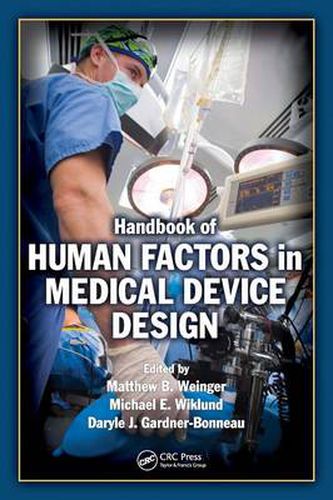Readings Newsletter
Become a Readings Member to make your shopping experience even easier.
Sign in or sign up for free!
You’re not far away from qualifying for FREE standard shipping within Australia
You’ve qualified for FREE standard shipping within Australia
The cart is loading…






Developed to promote the design of safe, effective, and usable medical devices, Handbook of Human Factors in Medical Device Design provides a single convenient source of authoritative information to support evidence-based design and evaluation of medical device user interfaces using rigorous human factors engineering principles. It offers guidance on user-centric design supported by discussions of design issues, case studies, and examples. The book sets the foundation with coverage of fundamental topics such as aligning the interactive nature of medical devices to the expected use environments ranging from hospitals and ambulances to patients’ homes, drawing on anthropometric and biomechanical data to ensure that designs match the intended users’ bodies and physical abilities, and conducting usability tests and other evaluations to ensure that devices perform as intended. It then focuses on applied design issues, offering guidance on the design of specific types of devices and designing devices for particular use environments. Adapted in part from established design standards and conventions, the design guidance presented in this work distills professional judgment extracted from the contributing authors’ years of experience in applied analysis and design. Written in true handbook style, each chapter stands alone and includes tables, illustrations, and cross references, allowing you to quickly find the exact information you need. Most chapters begin with a general introduction to the selected topic, followed by the presentation of general and special design considerations and then specific, numbered design guidelines. The book also presents a listing of resources, literature, and website references. It not only focuses on the human factors issues that arise when developing medical devices, it supplies the necessary guidance to resolve them.
$9.00 standard shipping within Australia
FREE standard shipping within Australia for orders over $100.00
Express & International shipping calculated at checkout
Developed to promote the design of safe, effective, and usable medical devices, Handbook of Human Factors in Medical Device Design provides a single convenient source of authoritative information to support evidence-based design and evaluation of medical device user interfaces using rigorous human factors engineering principles. It offers guidance on user-centric design supported by discussions of design issues, case studies, and examples. The book sets the foundation with coverage of fundamental topics such as aligning the interactive nature of medical devices to the expected use environments ranging from hospitals and ambulances to patients’ homes, drawing on anthropometric and biomechanical data to ensure that designs match the intended users’ bodies and physical abilities, and conducting usability tests and other evaluations to ensure that devices perform as intended. It then focuses on applied design issues, offering guidance on the design of specific types of devices and designing devices for particular use environments. Adapted in part from established design standards and conventions, the design guidance presented in this work distills professional judgment extracted from the contributing authors’ years of experience in applied analysis and design. Written in true handbook style, each chapter stands alone and includes tables, illustrations, and cross references, allowing you to quickly find the exact information you need. Most chapters begin with a general introduction to the selected topic, followed by the presentation of general and special design considerations and then specific, numbered design guidelines. The book also presents a listing of resources, literature, and website references. It not only focuses on the human factors issues that arise when developing medical devices, it supplies the necessary guidance to resolve them.